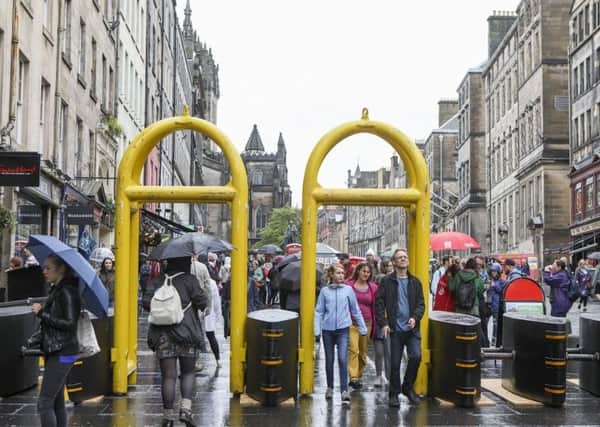Fringe chiefs: Royal Mile '˜soft target' for terror before barriers


Officials in charge of the street performance arena on the Royal Mile said they were worried the event was “vulnerable” in the wake of the 2016 Bastille Day atrocity in Nice.
They have revealed fears that makeshift barriers put together using the base of council road signs and sandbags would not be enough to thwart a “determined attacker”.
Advertisement
Hide AdAdvertisement
Hide AdOrganisers have also disclosed that some performers were considering pulling out of this year’s event in the aftermath of the Manchester and London terror attacks.
The concerns were revealed at a panel on safety and security at a national events conference at Strathclyde University in Glasgow.
Andy Meldrum, street events manager for the Edinburgh Festival Fringe Society, said around 15,000 people can be in the Royal Mile at any one time during the event, with up to 50,000 flocking to the area on a daily basis.
Mr Meldrum, who said he expected the barriers would remain in place for at least another 18 months, added: “The Nice attacks happened just two weeks before we opened. We didn’t have time to introduce robust procedures to prevent vehicle attacks.
“We couldn’t close the road using concrete blocks because residents and businesses still needed access outside the event times and a permanent road block would have prevented emergency vehicles coming into the area if needed.
“We ended up re-purposing council road signs and material to make makeshift road blocks. I doubt whether they would have stopped a determined attacker but at least it was some kind of visual deterrent. But I certainly felt the event was vulnerable compared to other events in the city and that we were an obvious soft target.”
Security measures were stepped up at major events across Scotland this summer after the atrocities in England.
Advertisement
Hide AdAdvertisement
Hide AdJust days before this year’s festivities got under way, it emerged that new security barriers would be introduced at key points around the city centre, including at the main entrance and exit points to the street theatre arena on the Royal Mile.
At the time police chiefs said the measures – which were approved and paid for by the UK government – were intended to “help keep people safe whilst attending events at Edinburgh Castle and the High Street in the event of vehicle as a weapon attacks, such as those seen at Westminster Bridge and Borough Market in London”.
Mr Meldrum told the conference: “After the attacks in Manchester and London in May and June, the security concerns for the Edinburgh Festival were growing and people were scared. I had performers and participants considering pulling out because they were fearful that something might happen.
“Around two weeks before the event was due to happen, somebody somewhere decided Edinburgh needed a more robust security system.
“We also had armed police on patrol for the first time, but they actually became one of the most popular attractions on the Royal Mile. People were going up and taking their photographs and getting selfies taken with them.
“I was actually quite surprised just how easily the public took to that kind of deployment. They very much took it in their stride.”